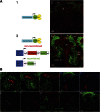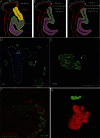Invasion of distal nephron precursors associates with tubular interconnection during nephrogenesis
- PMID: 22904347
- PMCID: PMC3458467
- DOI: 10.1681/ASN.2012030283
Invasion of distal nephron precursors associates with tubular interconnection during nephrogenesis
Abstract
Formation of a functional renal network requires the interconnection of two epithelial tubes: the nephron, which arises from kidney mesenchyme, and the collecting system, which originates from the branching ureteric epithelium. How this connection occurs, however, is incompletely understood. Here, we used high-resolution image analysis in conjunction with genetic labeling of epithelia to visualize and characterize this process. Although the focal absence of basal lamina from renal vesicle stages ensures that both epithelial networks are closely apposed, we found that a patent luminal interconnection is not established until S-shaped body stages. Precursor cells of the distal nephron in the interconnection zone exhibit a characteristic morphology consisting of ill-defined epithelial junctional complexes but without expression of mesenchymal markers such as vimentin and Snai2. Live-cell imaging revealed that before luminal interconnection, distal cells break into the lumen of the collecting duct epithelium, suggesting that an invasive behavior is a key step in the interconnection process. Furthermore, loss of distal cell identity, which we induced by activating the Notch pathway, prevented luminal interconnection. Taken together, these data support a model in which establishing the distal identity of nephron precursor cells closest to the nascent collecting duct epithelium leads to an active cell invasion, which in turn contributes to a patent tubular interconnection between the nephron and collecting duct epithelia.
Figures





Comment in
-
Connecting the segments.J Am Soc Nephrol. 2012 Oct;23(10):1603-5. doi: 10.1681/ASN.2012080850. Epub 2012 Sep 13. J Am Soc Nephrol. 2012. PMID: 22975669 No abstract available.
References
-
- Samakovlis C, Manning G, Steneberg P, Hacohen N, Cantera R, Krasnow MA: Genetic control of epithelial tube fusion during Drosophila tracheal development. Development 122: 3531–3536, 1996 - PubMed
-
- Sherwood DR: Cell invasion through basement membranes: An anchor of understanding. Trends Cell Biol 16: 250–256, 2006 - PubMed
-
- Sherwood DR, Butler JA, Kramer JM, Sternberg PW: FOS-1 promotes basement-membrane removal during anchor-cell invasion in C. elegans. Cell 121: 951–962, 2005 - PubMed
-
- Sherwood DR, Sternberg PW: Anchor cell invasion into the vulval epithelium in C. elegans. Dev Cell 5: 21–31, 2003 - PubMed
Publication types
MeSH terms
Substances
Grants and funding
LinkOut - more resources
Full Text Sources
Other Literature Sources
Research Materials

